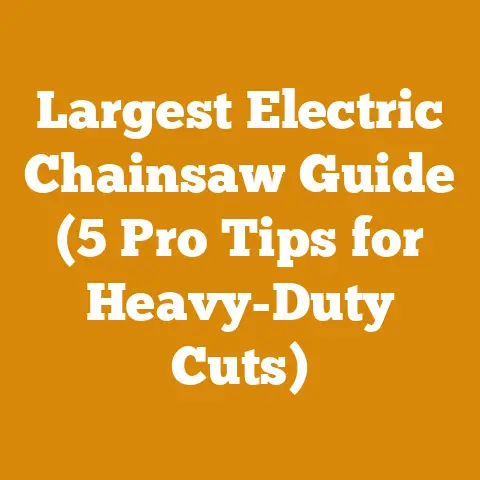Husqvarna 455 Chainsaw Guide (5 Pro Tips for Optimal Bar Length)
Durability is the name of the game when you’re talking about chainsaws, especially the Husqvarna 455. It’s a workhorse. But even the toughest saw needs the right setup to truly shine. And that’s where bar length comes in. Choosing the optimal bar length for your Husqvarna 455 isn’t just about slapping on whatever you find; it’s about maximizing performance, safety, and the lifespan of your saw.
Husqvarna 455 Chainsaw Guide: 5 Pro Tips for Optimal Bar Length
Finding the sweet spot for your Husqvarna 455’s bar length is crucial. It’s not a one-size-fits-all situation. The right bar will make your cutting smoother, safer, and more efficient. The wrong bar? Well, you’re looking at a strained engine, increased kickback risk, and a whole lot of frustration. In this guide, I’ll share 5 pro tips to help you choose the perfect bar length for your Husqvarna 455, along with some real-world cost considerations that often get overlooked.
Tip #1: Understand Your Cutting Needs
Before even thinking about inches, ask yourself: What am I really going to be cutting? Are we talking about limbing small branches, felling medium-sized trees for firewood, or tackling some serious timber? Your primary use case will dictate the ideal bar length.
- Small Branches & Limbing (Up to 6 inches): A shorter bar (16-18 inches) is your best bet. It’s lighter, more maneuverable, and reduces the risk of kickback when you’re working at awkward angles.
- Firewood & Small to Medium Trees (6-12 inches): A mid-range bar (18-20 inches) offers a good balance of power and control. It’s versatile enough for most firewood tasks and can handle trees up to a decent diameter.
- Larger Trees & Occasional Felling (12+ inches): A longer bar (20-24 inches) is necessary for felling larger trees. It provides the reach and cutting capacity you need, but be prepared for more weight and a greater risk of kickback.
I remember one time, I was helping a buddy clear some land for a cabin. He had a brand-new Husqvarna 455 with a 24-inch bar. Looked impressive, right? But he was mostly limbing smaller branches. He was constantly fighting the weight and struggling with control. After a few hours, he was exhausted. I suggested he switch to a shorter bar (I conveniently had an 18-inch one in my truck – always be prepared!). The difference was night and day. He was able to work faster, with more precision, and with far less fatigue.
Cost Considerations: While the initial cost of a bar is relatively low (ranging from $30 to $80, depending on the brand and length), consider the long-term implications. A longer bar used for small tasks will wear out the chain faster, leading to more frequent sharpening and replacement. A shorter bar struggling to cut large logs will put extra strain on the engine, potentially shortening its lifespan.
Tip #2: Consider the Engine Power of Your Husqvarna 455
The Husqvarna 455 has a decent engine, but it’s not a powerhouse. Overburdening it with too long of a bar will lead to poor performance and potential damage.
- Optimal Range: For the Husqvarna 455, I generally recommend a bar length between 16 and 20 inches. This range allows the engine to operate efficiently without being overly stressed.
- The “Two-Inch Rule”: A good rule of thumb is the “two-inch rule.” The bar length should be no more than two inches longer than the diameter of the wood you’ll be cutting most frequently. This ensures the engine has enough power to pull the chain through the wood without bogging down.
- Beyond 20 Inches: While you can technically put a longer bar on a Husqvarna 455, I wouldn’t recommend it unless you’re only occasionally cutting larger trees. The engine will struggle, and you’ll likely experience a significant decrease in cutting speed and overall performance.
Data Point: According to Husqvarna’s official specifications, the 455 Rancher is designed to handle bars up to 20 inches effectively. Pushing beyond that limit can void the warranty and potentially damage the engine.
Cost Considerations: Using an oversized bar will increase fuel consumption. The engine has to work harder to turn the chain, resulting in more frequent refueling. Over time, this can add up significantly. Also, consider the cost of engine repairs. A strained engine is more likely to experience premature wear and tear, leading to costly repairs down the road. I’ve seen people try to save a few bucks by using the wrong bar, only to end up spending hundreds on engine repairs later.
Tip #3: Factor in Wood Type and Density
The type of wood you’re cutting plays a significant role in determining the optimal bar length. Hardwoods like oak, maple, and hickory require more power to cut than softwoods like pine, fir, and cedar.
- Softwoods: If you’re primarily cutting softwoods, you can generally get away with a slightly longer bar. The wood is easier to cut, so the engine won’t be as stressed.
- Hardwoods: For hardwoods, I recommend sticking to the lower end of the recommended bar length range. This will ensure the engine has enough power to cut through the dense wood efficiently.
- Frozen Wood: Cutting frozen wood is a whole different ballgame. It’s significantly harder than unfrozen wood and requires even more power. If you’re cutting frozen wood, I recommend using a shorter bar and a sharp chain.
Personal Story: I once tried to fell a large oak tree in the dead of winter with my Husqvarna 455 and a 20-inch bar. The wood was frozen solid, and the saw struggled to make any progress. I ended up switching to a 16-inch bar and a brand-new chain, and the difference was remarkable. The saw was able to cut through the frozen wood much more easily.
Cost Considerations: Cutting hardwoods requires sharper chains and more frequent sharpening. Dull chains put even more strain on the engine and can lead to increased fuel consumption. Invest in a good chain sharpener and learn how to use it properly. The cost of sharpening equipment (files, grinders) can range from $20 to $100, but it’s a worthwhile investment in the long run. Also, consider the cost of chain replacement. Cutting hardwoods will wear out your chains faster, so factor that into your budget. Chains typically cost between $20 and $40, depending on the length and type.
Tip #4: Prioritize Safety and Control
Safety should always be your top priority when using a chainsaw. Choosing the right bar length can significantly reduce the risk of accidents.
- Kickback: Kickback is one of the most common and dangerous chainsaw injuries. A longer bar increases the risk of kickback, especially when cutting at the tip of the bar.
- Control: A shorter bar is easier to control, especially for beginners. It’s less likely to get caught or bind in the wood, reducing the risk of accidents.
- Fatigue: A longer bar is heavier and more tiring to use. This can lead to decreased focus and an increased risk of errors, which can result in accidents.
Safety Tip: Always wear appropriate safety gear when using a chainsaw, including a helmet, eye protection, hearing protection, gloves, and chaps. And never operate a chainsaw when you’re tired or under the influence of drugs or alcohol.
Cost Considerations: The cost of safety gear is minimal compared to the potential cost of a chainsaw injury. A good quality helmet can cost between $50 and $100, eye protection costs around $10-$30, hearing protection is $20-$50, gloves are $10-$30, and chaps are $80-$150. Don’t skimp on safety gear. It’s an investment in your health and well-being. Also, consider the cost of medical expenses. Even a minor chainsaw injury can result in a trip to the emergency room and a hefty medical bill.
Tip #5: Experiment and Find What Works Best for You
Ultimately, the best bar length for your Husqvarna 455 is the one that you’re most comfortable and confident using. Don’t be afraid to experiment with different bar lengths to find what works best for you and your specific cutting needs.
- Rent Before You Buy: If you’re unsure which bar length to choose, consider renting a chainsaw with different bar lengths. This will allow you to try them out and see which one you prefer before making a purchase. Rental fees typically range from $30 to $50 per day.
- Talk to Experienced Users: Ask other chainsaw users for their advice and recommendations. They may have valuable insights based on their own experiences.
- Practice Makes Perfect: The more you use your chainsaw, the better you’ll become at judging the right bar length for different tasks. Practice in a safe and controlled environment until you’re comfortable and confident.
Personal Story: When I first started using chainsaws, I was intimidated by the longer bars. I thought they were too powerful and dangerous. But as I gained more experience, I realized that a longer bar can be a valuable tool, especially for felling larger trees. I still prefer a shorter bar for limbing and general firewood tasks, but I’m comfortable using a longer bar when the situation calls for it.
Cost Considerations: The cost of experimentation can be minimal. Borrowing a chainsaw from a friend or renting one for a day is a relatively inexpensive way to try out different bar lengths. The key is to be safe and responsible. Always follow the manufacturer’s instructions and wear appropriate safety gear. Also, consider the cost of your time. Experimenting with different bar lengths will take time and effort, but it’s a worthwhile investment in your skills and knowledge.
Digging Deeper: The Nitty-Gritty of Chainsaw Costs
Choosing the right bar length is just one piece of the chainsaw cost puzzle. Let’s delve into the broader cost landscape, examining everything from initial purchase to long-term maintenance and operation.
Initial Purchase Costs: Beyond the Sticker Price
The sticker price of a Husqvarna 455 Rancher is just the starting point. Here’s a breakdown of potential initial costs:
- Chainsaw Itself: The Husqvarna 455 Rancher typically retails for between $400 and $500. Prices can vary depending on the retailer, location, and any ongoing promotions.
- Bar and Chain: The standard bar and chain are usually included, but you might want to upgrade to a higher-quality chain or purchase an additional bar for different tasks. As mentioned earlier, bars cost $30-$80, and chains cost $20-$40.
- Safety Gear: As emphasized earlier, safety gear is non-negotiable. Expect to spend $150-$300 on a helmet, eye protection, hearing protection, gloves, and chaps.
- Fuel and Oil: You’ll need fuel and bar oil to get started. A gallon of pre-mixed fuel costs around $15-$20, and a gallon of bar oil costs around $10-$15.
- Tools and Accessories: A chain sharpener, a file guide, a felling wedge, and a chainsaw carrying case are all useful accessories. These can add another $50-$150 to your initial costs.
Example Scenario: Let’s say you’re buying a Husqvarna 455 Rancher and want to be fully equipped:
- Chainsaw: $450
- Extra Chain: $30
- Safety Gear: $200
- Fuel and Oil: $30
- Tools and Accessories: $100
- Total Initial Cost: $810
Financing Considerations: If you’re on a tight budget, consider financing options. Many retailers offer financing plans, but be sure to compare interest rates and fees before signing up.
Ongoing Costs: The Real Cost of Ownership
The initial purchase is just the beginning. Here’s a breakdown of the ongoing costs associated with owning a Husqvarna 455:
- Fuel and Oil: Fuel consumption varies depending on the type of wood you’re cutting and the bar length you’re using. Expect to spend $5-$10 per hour on fuel and oil.
- Chain Sharpening: A dull chain is inefficient and dangerous. You can sharpen your own chains or pay a professional to do it for you. Professional sharpening typically costs $10-$15 per chain.
- Chain Replacement: Chains wear out over time and need to be replaced. Expect to replace your chain every 50-100 hours of use, depending on the type of wood you’re cutting.
- Bar Maintenance: Chainsaw bars also wear out over time and need to be replaced. Expect to replace your bar every 200-400 hours of use.
- Air Filter Cleaning/Replacement: A clean air filter is essential for proper engine performance. Clean the air filter regularly and replace it as needed. Air filters typically cost $5-$10.
- Spark Plug Replacement: Spark plugs also wear out over time and need to be replaced. Expect to replace your spark plug every 100-200 hours of use. Spark plugs typically cost $5-$10.
- Repairs and Maintenance: Chainsaws require regular maintenance and occasional repairs. Expect to spend $50-$100 per year on repairs and maintenance.
Example Scenario: Let’s say you use your Husqvarna 455 for 100 hours per year:
- Fuel and Oil: $750 (100 hours x $7.50/hour)
- Chain Sharpening: $150 (10 chains x $15/chain)
- Chain Replacement: $30 (1 chain x $30/chain)
- Bar Maintenance: $20 (assuming you can maintain the bar yourself)
- Air Filter/Spark Plug: $15
- Repairs and Maintenance: $75
- Total Annual Cost: $1040
Cost-Saving Tips:
- Sharpen your own chains: Learning to sharpen your own chains can save you a significant amount of money over time.
- Perform regular maintenance: Keeping your chainsaw properly maintained will help prevent costly repairs.
- Buy fuel and oil in bulk: Buying fuel and oil in bulk can save you money in the long run.
- Shop around for parts and accessories: Prices for parts and accessories can vary widely. Shop around to find the best deals.
The Hidden Costs: Beyond the Obvious
There are also some hidden costs associated with owning a chainsaw that are often overlooked:
- Transportation: Transporting your chainsaw to and from the job site can add to your costs. Consider the cost of fuel and vehicle maintenance.
- Storage: You’ll need a safe and secure place to store your chainsaw. Consider the cost of a storage shed or garage.
- Permits and Licenses: In some areas, you may need a permit or license to cut down trees. Check with your local authorities to see if any permits or licenses are required.
- Insurance: Consider insuring your chainsaw against theft or damage.
- Training: Proper chainsaw training can help you avoid accidents and injuries. Consider taking a chainsaw safety course.
Data Point: According to the Occupational Safety and Health Administration (OSHA), chainsaw accidents result in an estimated 36,000 injuries per year in the United States. The average cost of a chainsaw injury is $30,000.
Cost Considerations: The cost of these hidden expenses can add up quickly. Be sure to factor them into your budget.
Budgeting for Firewood Preparation: A Real-World Case Study
Let’s look at a real-world case study to illustrate how to budget for firewood preparation:
Scenario: You want to prepare 5 cords of firewood for the winter. You have a Husqvarna 455 Rancher with a 18-inch bar. You plan to fell the trees yourself on your property.
Cost Breakdown:
- Timber Purchase: (Assuming you already own the land, this cost is $0. If you need to purchase timber, prices vary wildly by region and species. Let’s assume $50 per cord standing, so $250)
- Fuel and Oil: $375 (50 hours x $7.50/hour)
- Chain Sharpening: $75 (5 chains x $15/chain)
- Chain Replacement: $30 (1 chain x $30/chain)
- Equipment Rental (Wood Splitter): $200 (assuming you rent a wood splitter for one day)
- Transportation: $50 (fuel for your truck)
- Permits (if required): $50
- Labor (Your Time): This is a tricky one. How much is your time worth? Let’s say you value your time at $20 per hour, and it takes you 50 hours to prepare the firewood. That’s $1000.
- Total Cost (Without Your Labor): $1030
- Total Cost (Including Your Labor): $2030
Analysis:
- Preparing firewood yourself can be a cost-effective way to heat your home, but it’s important to factor in all of the costs, including your time.
- If you value your time highly, it may be more cost-effective to purchase firewood from a supplier.
- The cost of timber can vary widely depending on the region and species.
- Renting a wood splitter can save you a significant amount of time and effort.
- Always obtain any necessary permits before cutting down trees.
Industry Benchmarks:
- The average price of firewood in the United States is $200-$400 per cord, depending on the region and species.
- The cost of hiring a professional to fell trees can range from $500 to $2000 per tree, depending on the size and location of the tree.
- The cost of renting a wood splitter can range from $50 to $100 per day.
Actionable Takeaways and Next Steps
Choosing the right bar length for your Husqvarna 455 is essential for maximizing performance, safety, and the lifespan of your saw. By understanding your cutting needs, considering the engine power of your saw, factoring in wood type and density, prioritizing safety and control, and experimenting to find what works best for you, you can choose the perfect bar length for your specific applications.
Here are some actionable takeaways and next steps:
- Assess Your Cutting Needs: Determine the type of wood you’ll be cutting most frequently and the diameter of the trees you’ll be felling.
- Consider Your Skill Level: If you’re a beginner, start with a shorter bar for better control.
- Experiment with Different Bar Lengths: If possible, rent or borrow chainsaws with different bar lengths to find what works best for you.
- Invest in Safety Gear: Always wear appropriate safety gear when using a chainsaw.
- Learn Proper Chainsaw Techniques: Take a chainsaw safety course to learn how to use your chainsaw safely and efficiently.
- Maintain Your Chainsaw Regularly: Keep your chainsaw properly maintained to prevent costly repairs.
- Budget for All Costs: Factor in all of the costs associated with owning and operating a chainsaw, including fuel, oil, chain sharpening, repairs, and maintenance.
By following these tips, you can choose the right bar length for your Husqvarna 455 and enjoy years of safe and productive wood cutting.
Remember, the goal is to work smarter, not harder. The right bar length, combined with proper technique and a well-maintained saw, will make all the difference in your wood processing and firewood preparation projects. Now, get out there and make some sawdust!






